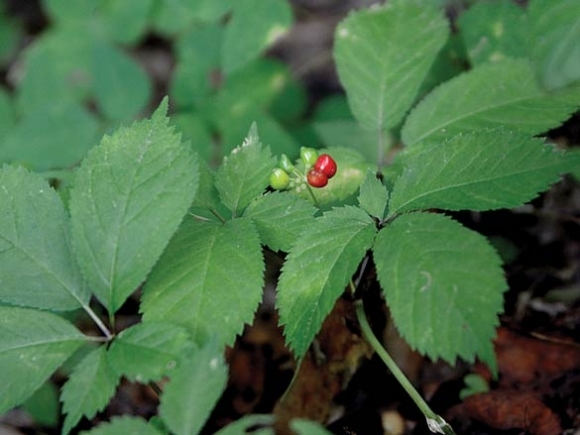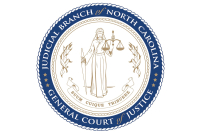Protecting mountain gold: Balsam uses dye to thwart ginseng poachers

Brian McMahan and Johnny Nicholson can both remember boyhood days spent in the mountains, hunting the elusive ginseng plant.
Coveted for its myriad medicinal uses, ginseng root harvest is an Appalachian tradition stretching back through generations. McMahan and Nicholson were both taught to dig it in such a way that its numbers would stay strong for generations more — leaving small plants to grow and planting the seed-containing berries of harvested plants in the earth around the dig.
“Most of the time we would ginseng dig to get money to buy a hunting license or something like that,” Nicholson said. “But the old-timers never dug it before the berries got ripe.”
These days, both men work for the Balsam Mountain Preserve in Jackson County — McMahan as chief security officer and Nicholson as operations manager — and they’ve spent untold hours working to protect the Preserve’s wild ginseng from poachers who aren’t interested in harvesting the plant legally or responsibly.
“Today, these poachers just take everything,” McMahan said. “They take the big stuff, they take the little stuff. They even take it before it has berries that are available to plant.”
Related Items
A help for prosecution
McMahan’s hoping that a new effort underway at the Preserve will soon keep the poachers at bay. Working with homeowners in the community and the Balsam Mountain Trust, the Preserve is attempting to apply chemical markers to as many of the ginseng plants growing on the Preserve’s 4,400 acres as possible.
It’s been a labor-intensive process, involving a systematic canvass of the rugged property to map where the biggest communities of ginseng grow so that the team can apply the dye to each plant found. The dye is absorbed through the roots. It doesn’t hurt the plant or change the appearance of its above-ground portion, but it does remain in the plant through the rest of its life.

A poacher digging up a treated root would quickly see that it looks different from a typical ginseng root — and that variation in color would make the find virtually worthless to sellers. Licensed ginseng sellers are monitored to ensure their activities are legal, McMahan said, and while your average ginseng root tells no tales as to whether it was harvested legally or illegally, it’s obvious at a glance that a dyed root was stolen.
The dye also features a chemical marker that is identifiable under a microscope, making it easy to prove in court that the root in question originated on the property of the Balsam Mountain Preserve.
For McMahan and his team, that’s pretty important. It’s illegal to harvest ginseng on private land like Balsam Mountain Preserve without permission from the landowner. But, while it’s easy to prove that someone was trespassing on the Preserve’s private property, it’s often hard to prove that someone caught poaching actually dug the ginseng they’re carrying on the property and didn’t just bring it with them from somewhere else. The chemical markers will make that a lot easier.
“If we catch a poacher and he has a bagful of ginseng, unless we actually see him digging it we can’t prove he got it on our property. But when he’s got it in his bag and it has dye in it, then we know it came from Balsam and we can prosecute. That’s going to be a great help,” Nicholson said.
An ongoing process
The ginseng-marking project, now in its first year, has been a long time in the making. Before Balsam Mountain Preserve was created 15 years ago, the N.C. Wildlife Resources Commission managed the property as gameland, which meant it was open to the public.
When Balsam Mountain bought the land and it became private property, poaching problems soon ensued. McMahan has found himself on many a stakeout over the years, waiting at some forest edge where it’s expected a poacher will eventually emerge.
About three or four years ago, Balsam Mountain began collaboration with N.C. State University toward securing its ginseng population. The university studied the ginseng population within the Preserve’s boundaries, identifying the places where it grows best and determining the health of those various populations. From there, the Preserve worked with the N.C. Department of Agriculture and Consumer Services to come up with a proactive plan for ginseng protection — root-marking.
Some of the homeowners on the property got excited about the idea and lent their hands to the arduous task of traversing the property in search of ginseng to protect. It’s not easy. The forests of the Balsam Mountain Preserve grow on steep slopes with a lush understory that makes travel slow and ginseng hunting sometimes a search for a needle in a haystack. To further complicate matters, ginseng doesn’t sprout every year — some years, plants will lie dormant, with the roots resting hidden underground.
“This is an ongoing process,” Nicholson said.
“It’s tough. It involves a lot of manpower,” McMahan added.
They expect it to be worthwhile in the long run, though — for the Preserve, for the ecosystem and for the community at large.
“In most cases, most of these people are doing other things other than stealing ginseng,” McMahan said. “We’re catching people who may be in possession of drugs and illegal substances. Who knows what else they tack on when they catch some of these people. People who break the law to do ginseng will be breaking the law to do other things.”
The drug epidemic has contributed to the prevalence of ginseng theft. The roots can sell for hundreds of dollars per pound. Drug users in need of drug money sometimes see ginseng as a source of quick cash.
“The worst crowd to deal with are those who are trying to dig it for money to buy drugs,” McMahan said.
These poachers dig plants of any size, in any season — the goal is to get as much money as possible as quickly as possible, not to harvest with an eye toward allowing the species to propagate.
“Here in Jackson County we have received a lot of help from our local sheriff’s department,” Nicholson added. “They have really been good to help us anytime we call them.”
The Preserve is tapping into additional anti-poaching technologies as well, setting up trail cameras in some locations to take pictures anytime a poacher moves in the vicinity. Those images can become evidence in court.
“The technology has come a long ways, and the price of that stuff has gone down,” McMahan said.
The jury’s still out on how effective the dye markers will be for combating poaching on the Preserve, but the same method has been used in other places, with substantial success, Nicholson said.
Hopefully, that success will translate to Balsam.
The facts on ‘sang
Ginseng — of which there is one American and one Asian species — has a history of medicinal use on both continents that goes back centuries.
The plant’s root is said to have a wide variety of medical benefits, though not all of these have been substantiated through scientific studies. Its alleged effects include boosting the immune system, improving concentration and learning, and treating a spectrum of medical conditions.
American ginseng, Panax quinquefolius, is native throughout the Appalachian Mountains and in states as far west as Minnesota. Its leaves grow in sets of five — hence, its Latin name — and in the fall it displays a stalk of bright red berries.
However, the plant’s almost mythic place in the world of herbal medicine — and its high-dollar market value — has led to widespread poaching and population declines. In North Carolina it’s classified as a species of special concern, and in recent years the U.S. Forest Service has restricted the number of permits it issues each year for legal harvesting in the Pisgah-Nantahala National Forest. Since 2013, permit numbers have decreased by 75 percent and are granted through a lottery system.
Harvesting ginseng illegally is considered theft and prosecuted accordingly. Poaching plants from federal land carries a fine of up to $5,000, a six-month federal prison sentence, or both.









